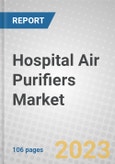This report reviews the importance of air purifiers in healthcare, the manufacturing process, and regulatory settings. It then discusses some of the investments and clinical trials in the air purifier market. The main market-driving forces are also discussed.
The report examines the markets by product type, technology basis, settings, and region. The report provides market data and forecasts for the air purifier market by product type, including HEPA and non-HEPA filters. HEPA filters are classified into medical-grade HEPA and non-medical grade HEPA. Non-HEPA filters include carbon, electric, and others.
Specific geographic markets are discussed, including North America, Europe, Asia-Pacific, and Rest of the World.
The publisher summarizes the main industry acquisitions and strategic alliances from January 2020 through December 2022, including key alliance trends.
Report Includes
- 21 data tables and 28 additional tables
- An overview and industry analysis of the global market for hospital air purifiers
- Analyses of the market trends, with historical market revenue data (sales figures) for 2022, estimates for 2023, forecasts for 2024 and projections of compound annual growth rates (CAGRs) through 2028
- Estimates of the market size and revenue forecasts for the hospital air purifier market, and a corresponding analysis of market share based on product type, coverage area, technology and region
- In-depth information (facts and figures) concerning the major factors influencing this market (drivers, restraints, opportunities and industry-specific challenges)
- Analysis of the market growth opportunities through Porter’s Five Forces and PESTLE analyses, taking into consideration the prevailing micro
- and macro environmental factors
- Evaluation of the ESG practices of leading companies in the market, with emphasis on the impact of ESG on performance, ratings and matrices, as well as consumer attitudes
- A look at the major vendors, along with an analysis of the industry structure with respect to company value share, M&A and venture funding
- Identification of the major stakeholders, and an analysis of the competitive landscape based on recent developments, key financials, segmental revenues, and operational integration
- Company profiles of major players within the industry, including Daikin Industries Ltd., Honeywell Interntional Inc., IQAir, and Koninklijke Philips NV.
Table of Contents
Executive Summary
The World Health Organization has declared air pollution as the single largest environmental concern affecting the health of a person. There have been increasing levels of outdoor pollution as well as indoor pollution. A person spends 90% of their time indoors and is affected by the indoor air quality. Hospital air is polluted by a variety of substances that are organic as well as inorganic in nature. Hospital air can lead to many problems; Hence, it is imperative to monitor as well as control hospital and healthcare air quality.The major factors driving the market are the growing number of hospitals, particularly in the Asian countries of India and China, and in Latin American countries. New hospitals require a well-established ventilation system equipped with high-quality air filters and purifiers, which will drive the market. Additionally, the growing concerns related to the pandemic and hospital-acquired infection due to poor air quality is also a major driving factor for air purifiers in hospitals.
The market's major restraint is low-cost low-quality devices that are available on the market. These devices are generally manufactured in Asian countries and there are no spare parts and replacements that are easily available. This has led to a negative mindset toward the product category, which is affecting its sales. Additionally, the declining number of hospitals in regions such as Europe, Japan, and other developed regions is limiting the opportunities in this segment.
There is a growing opportunity for standalone units due to the pandemic. There was lot of research carried out to study the effectiveness of standalone units in cases of COVID-19. The results of most of the studies are promising. Additionally, standalone units can be used in smaller spaces such as doctors' cabins and clinics, which were previously using air purifiers. These units can also be used in ambulances and other emergency departments where there are no air purifiers currently.








